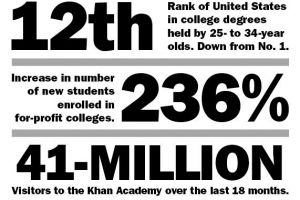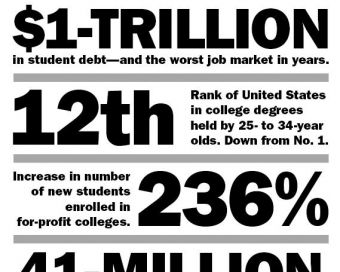CUNY’s Ann Kirschner has an excellent piece in the Chronicle of Higher Education exploring how much innovation is really happening in US higher education. A nice read for anyone interested in the present and future of higher education.
Even major higher-education projects and government initiatives are just playing around the margins. Take the international-export activity in education: Some institutions have indeed begun ambitious expansions with overseas branch campuses or partnerships, but they are merely transporting the old model to new physical space abroad. Or technology: Although e-learning has been around for nearly 20 years, technology in and out of the classroom is at the discretion of the professor, with rare institutional support or enthusiasm. Online learning has about as much credibility on some campuses as global warming at a Tea Party rally. About the only thing within academe that has moved rapidly is tuition.
A recent spate of books diagnoses the impediments to change and offers a broad menu of recommendations. We have Reinventing Higher Education: The Promise of Innovation, edited by Ben Wildavsky, Andrew Kelly, and Kevin Carey Harvard Education Press, 2011; the second edition of Higher Education? How Colleges Are Wasting Our Money and Failing Our Kids—and What We Can Do About It, by Andrew Hacker and Claudia Dreifus St. Martins Griffin, Reprint Edition, 2011; The Innovation University: Changing the DNA of Higher Education From the Inside Out, by Clayton M. Christensen and Henry J. Eyring Jossey-Bass, 2011; and Change.edu: Rebooting for the New Talent Economy, by Andrew S. Rosen Kaplan Publishing 2011.
Add to that the previous Crisis on Campus: A Bold Plan for Reforming Our Colleges and Universities, by Mark C. Taylor Alfred A. Knopf, 2010. Notice the prevalence of those “transformation” words.
Most of the books are written by insiders, i.e., academics in varying disciplines, from economics to political science to business management and the humanities. And most of their conclusions are surprisingly consistent, especially about the ways in which academic culture strangles innovation and reform. Love and respect for our educational mission do not deter these writers from identifying the greatest hurdle to overcome in higher education: inertia.
As Taylor, a philosopher of religion at Columbia University, argues, until colleges accept the need to change, they have little incentive to overcome their natural inclination to stay the same. The reverence for tradition that sends graduating seniors walking out through the gate they entered as freshmen can permeate an institution’s entire world view: Honoring the past is a hedge against whatever barbarians are assaulting it in the present. For Taylor, inertia has turned into a crisis because tenure and traditional departments stifle the sharing of ideas.
Later in the piece Kirschner writes:
Ideas are everywhere, and innovation, technology, and accountability are their critical components. But they require tough choices and thick skins to survive the attack of the antibodies against change. Some university constituents hear the dreaded word “productivity” as a euphemism for bigger classes or just more classes taught on the backs of already overworked, underpaid adjuncts. In defense of the university, they head to the ramparts to demand increased state financing and cuts in administrator salaries, as if those were the only solutions.
I am often struck by how critics of university reform evoke “privatization” and “corporatization” as the twin demons that threaten to destroy the fabric of higher education. It would indeed be a sad world if the lofty goals of creating and transferring knowledge were reduced to the rhetoric and mechanics of the marketplace. However, surely we can learn something from the way commercial enterprises are driven to continual improvement by competition, consumer demand, and responsibility to their stakeholders. Students and their families, as well as taxpayers, legislators, and donors, pay dearly for the services of the university. There is nothing shameful or anti-intellectual or soulless in acknowledging that we are accountable to them.
via Innovations in Higher Education? Hah! – The Chronicle Review – The Chronicle of Higher Education.


